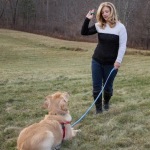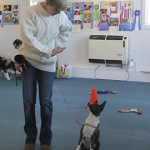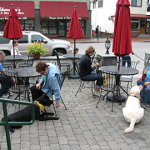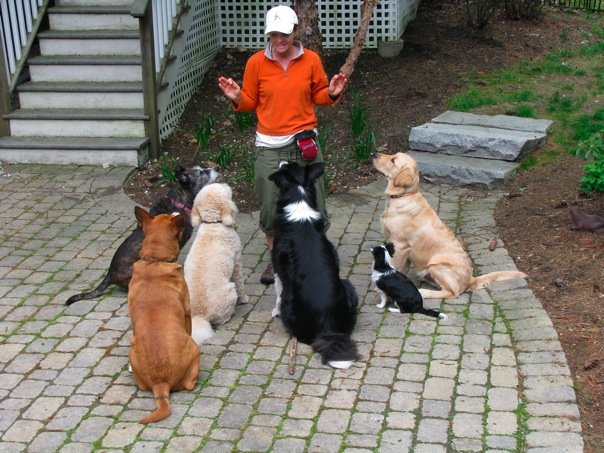
This is Blog #4 in helping the dog who is barking and lunging at people.
Step 1. Management; prevent him from practicing the unwanted behavior.
Step 2. Desensitization and counter condition; change how your dog feels.
Step 3. Understanding your dogs Distance Cues.
Step 4. Emotional Control Exercises, teaching your dog to sit and down stay will help your dog have better emotional control.
Begin training sessions of 5-10 minutes several times a day in a low distraction environment.(Some where in your home is a good place to start). The secret to a good stay is to not move through the stages too fast. Build up gradually by adding duration and distractions.

Using the Collar: Say dogs name and ask dog to sit, touch the collar and say “stay” while holding a flat hand in front of the dogs face. Reward quickly with a few treats, repeat. Now try it without holding the collar, “come, sit, stay” reward, reward, then release. Repeat while standing.
Using the Leash: Say dogs name and ask dog to “sit, stay” while a raising a flat hand. Reward quickly with a few treats, then release your dog and repeat.
Duration: You may have to reward with treats every few seconds, then release your dog. The goal is your dog will want to “stay” as this is rewarding, when you release him the food stops. If your dog moves before you release him, walk or look away and try the pattern again but reward generously until they understand what it is you are asking.
Add Criteria: Using your dogs daily meal, repeat this pattern “come, sit, stay” or “heel, sit, stay” reward and release, repeat while adding duration in every room of your house. Add higher criteria by having a familiar person walk past and reward generously if your dog holds his sit, stay. If he breaks, no worries, show him the food and repeat the pattern until he is successful. Progress to sit, stay outside in the driveway, yard and street with no distractions then add criteria by having a familiar person walk past and reward generously for good emotional control.

Success: By now your dog understands that when a person walks by “good things can happen.” If your dog training is failing, I will bet it is because the criteria is too high for the dog. Set your dog up for success and reward many repetitions of sit, stay or down,stay in many locations with only familiar friends passing by. As your dog matures, he will develop better emotional control in a variety of situations AND see people passing by as a predictor that good things can happen. If your dog does not have strong emotional control at home, then please do not ask him to sit and stay in a public location as this criteria is too high.
Time Frame: Each dog will progress at a different pace and they can only go at their pace. Factors that change how your dog feels and reacts can include how a person smells, how tall they are, male or female, how fast they move, if they make direct eye contact, if they are nervous, lean over the dog, cough, laugh or even stomp their feet. If there is one person or several makes a huge difference how each dog feels. If your dog goes over his comfort level, he may lunge and snap. Do not punish, simply slow the progression down until you reduce your dogs fear.
Personal Experience: I have progressed countless clients through this process, and two of my own dogs! I am not worried

about either of my dogs lunging or biting a guest. I rescued my Scottish Terrier at 5 years of age with a history of multiple bites, after 18 months of training she passed her Canine Good Citizen Certification and can now greet people in my house. For months, I had to introduce her to guests on the street, then in the yard and eventually inside my home, this is a detailed desensitization process. The good news is you will get there with your furry friend, just take your time, manage when you can not train, train below your dogs threshold and practice daily using his meal.


